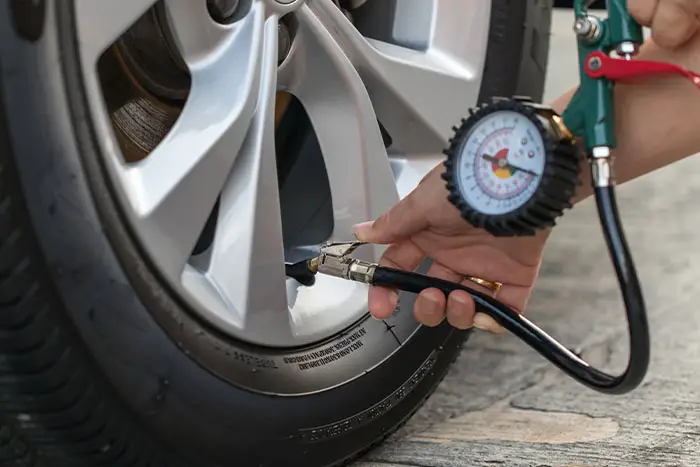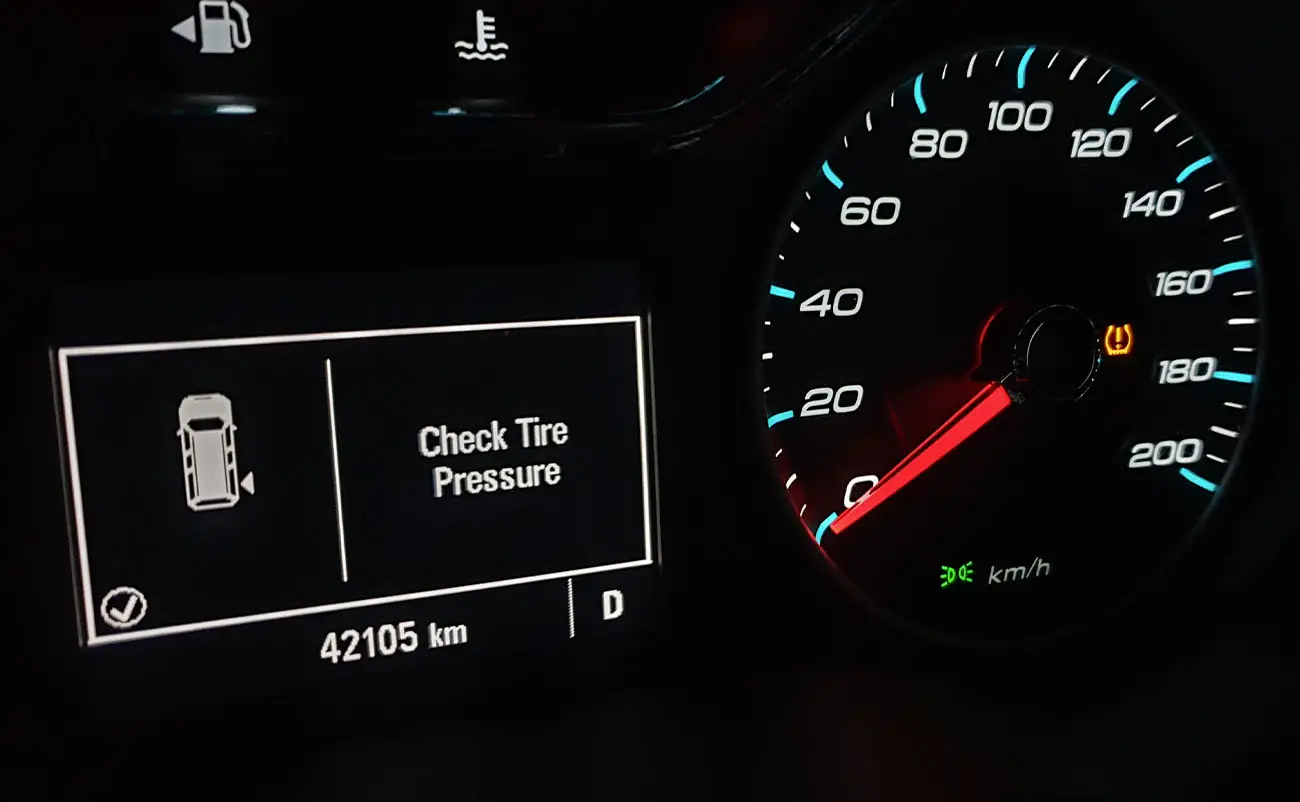The tire pressure warning light on your vehicle is designed to alert you when the pressure in your tires is too low. The tire pressure monitoring system, or TPMS, is a great safety feature that alerts you to low-pressure conditions that you might not otherwise notice. However, there are a few other conditions that can cause the warning light to illuminate besides improper air pressure in your tires. Tracking down the cause of the problem can sometimes be difficult, but we are here to help. We’ll give you the most common causes of tire pressure sensor faults and tell you how to fix them.
Table of Contents
What Causes A Tire Pressure Sensor Fault?
The light on your dashboard might look like a flat tire, or you could see a message on your dash indicating a problem with the TPMS system. Either way, the tire pressure light signals a problem of some kind. So, just what causes this tire pressure monitor fault to occur? Here are the most common culprits.
— Low Tire Pressure
This one should seem obvious as it is the very thing the system is designed to detect. Low tire pressure will cause an alert on your dashboard. Similarly, you might also get an alert if the pressure in a tire is too high. You should always refer to your owner’s manual for the proper air pressure for your tires, but each manufacturer has recommendations. There is typically a sticker inside the driver’s door that shows the proper pressure of each tire. Most vehicles range anywhere from 30 to 40 PSI, although some truck tires may require as much as 75 psi.
— Faulty TPMS Sensor
A bad sensor is one of the most common causes of a TPMS malfunction. There is a tire pressure sensor located in each tire on your vehicle, and each of these sensors maintains communication with the car’s computer. Just like any other sensor, these tire sensors sometimes malfunction. When a sensor malfunctions, the computer will report a TPMS error code. This error code triggers the tire pressure sensor fault, and you will see the warning light illuminate on your dashboard. When a sensor fails, it will almost always need to be replaced with a new sensor.
— Problems With TPMS System
A TPMS fault is not always just related to one specific sensor. Sometimes, the overall system may experience a problem. The car’s computer might lose communication with one or more of the sensors. The system can sometimes lose its memory, and the sensors may need to be reconnected to the computer. The TPMS control module can also fail, and this would cause a system fault. Some TPMS systems are also connected to other vehicle components, like the braking system or the traction control system. An issue with one of these other systems can sometimes cause a fault with the TPMS system, and you might see a “Service Engine Soon” message as well.
— Wiring Or Electrical Problems
Although the tire sensors are wireless, other parts of the TPMS system require electrical connections. A problem with the wiring or a connection point can cause a fault with the system. These connections can become corroded, and this could be the reason why you see the TPMS light on. The specific error code in the computer should assist with troubleshooting and point you in the direction of the problem.
How To Reset The Tire Pressure Light

Once you see the TPMS light illuminate, you probably wonder how to fix a tire pressure sensor. There are a few different things you might need to do to reset the light, and the specific corrective action depends on the cause of the tire pressure monitor problem. Here are some of the most common things you will need to do to make the TPMS light go away.
— Inflate Tires To The Proper Pressure
If you have a low tire, the fix is easy. Simply inflate your tires to the recommended PSI, and the light should disappear almost immediately. Remember that both underinflated and overinflated tires can cause a tire sensor fault message. Use a tire pressure gauge to make sure that each tire is inflated to the manufacturer’s recommendation. In most cases, it is not even necessary to restart your vehicle. As soon as the computer recognizes the proper pressure from each sensor, the light will reset and go away.
— Reset The Light With A Scan Tool
Just like resetting the check engine light, you can also reset a tire pressure sensor fault message with a scan tool. You will need to plug the scan tool into the OBD2 port on your vehicle. You can then clear the error code and reset the light using the tool. Remember that if you have a persistent problem, the light will return quickly. The cause of the issue must be fixed before resetting the light, or the light will reappear almost immediately. If you don’t have a scan tool, you can also disconnect the battery for a few seconds to perform a TPMS reset.
— Reprogram The Tire Pressure Sensors
There are a few instances when your sensors might need reprogramming. First, you should always reprogram your sensors when you rotate your tires. This will ensure that the computer knows which tire each sensor is located in. Some vehicles require different tire pressure in the front and rear tires, so you might experience a fault if the sensors are not programmed in the proper locations.
Next, if the sensors lose communication with the computer, they will need to be reprogrammed. Finally, if you change the tires on your car, you might need to reprogram the sensors. Some people have different sets of tires for different seasons, like summer or winter. When the tires are changed, the sensors will need to be reprogrammed.
— Replace Bad TPMS Sensor
As we already mentioned, if a TPMS sensor goes bad, it will need to be replaced. Faulty sensors cannot usually be repaired, and they need to be replaced with new ones. Once the sensor is replaced, the new sensor will need to be connected to the control module. Some vehicles might require that all the sensors be reprogrammed, while others will allow just the new sensor to be programmed into the system. Your dealership or local tire shop should be able to complete this process for you.
Where Is The Tire Pressure Sensor Located?
Tire pressure sensors are located inside each tire on your vehicle. There are a couple of different types of sensors, and the specific location inside the tire depends on the type of sensor used. The most common type of sensor is located on the valve stem. These sensors are integrated into the valve stem, and the sensor portion is located inside the tire at the base of the valve stem.
Some cars utilize band sensors inside the tires. These sensors are mounted inside the tire along the edge of the wheel or rim. A metal band is attached to the wheel and holds the sensor in place. There is not much difference in price between the two different types of sensors, and both types of sensors accomplish the same task. It is worth noting that the spare tire on most vehicles does not have a TPMS sensor inside of it.
The TPMS control module can be mounted in a variety of different places, depending on your specific vehicle. Some cars have the module located inside the front wheel well, while others have the module located inside the rear passenger pillar. If you need to locate the TPMS control module, you should refer to a repair manual for your specific make and model.
How To Replace A Tire Pressure Sensor

Most people are unable to replace a tire pressure sensor on their own because the job requires some specialized tools. The wheel and tire will need to be removed from the vehicle, and the tire will need to be unmounted from the wheel. This requires special equipment that usually only tire shops and other automotive repair facilities have.
Once the tire is unmounted, the faulty sensor can be removed. Whether you have the valve stem sensor or the band sensor, the general steps for this process are the same. Once you have removed the old sensor, the new sensor can be placed into the tire. The tire can be remounted onto the wheel and inflated to the correct pressure.
These sensors typically last for several years, and they do not always need to be replaced when you get new tires. However, you will need to make sure that the sensors are reprogrammed whenever your car tires are replaced. Reprogramming the sensors ensures that the computer knows where each sensor is located.
Average Cost Of TPMS Sensor Replacement
Thankfully, the cost of replacing a TPMS sensor is not extremely high. On average, it costs anywhere from $100 to $300 to replace a TPMS sensor. The specific price depends on the make and model of your vehicle. The sensors for some cars are much more expensive than others. Labor costs associated with the job are usually around $100, as it typically takes less than an hour to perform the work. An experienced technician can usually complete the job in about 30 minutes. This time includes replacing the sensor and reprogramming the TPMS system to recognize the new sensor.
As previously mentioned, most people cannot perform this work on their own, so there are not many ways to save money on this job. The biggest tip for saving money is to shop around. Call a few different shops in your area and request a quote from each of them. You might be able to save a few dollars by finding the shop that will perform the work for the lowest cost. However, make sure that you are visiting a reputable shop. Don’t sacrifice quality to save a few bucks.
The Bottom Line
Whether you have a Ford, Toyota, BMW, or anything in between, your car probably has tire pressure sensors if it was made in the last 15 years. These sensors can alert you to improper tire pressure and help prevent dangerous driving conditions. However, these sensors can sometimes malfunction. When things go wrong, you will see a warning light on your dashboard related to a tire pressure sensor fault. The fault could signal anything from low tire pressure to a problem with the TPMS system. Whatever the cause, you should get the issue repaired and then reset the light so that it goes off until another problem is encountered.
Frequently Asked Questions (FAQs)
Can I drive with a tire pressure sensor fault?
You can sometimes drive with a tire pressure sensor fault, although you should determine the cause of the light first. If the light is illuminated due to low tire pressure, you should visit a gas station or tire shop to inflate the tire to the proper pressure. Underinflated tires can result in a blowout due to excess heat and pressure on the sidewall. Low pressure will also lower your fuel economy and cause improper tire wear. If the fault is related to a faulty sensor or control module issue, then you should have no problems driving with the light on.
What do I need to do if my tire pressure sensor fault is on?
You should first determine the cause of the fault. If the fault is due to low tire pressure, you should get the problem corrected as soon as possible. Driving on a low tire is dangerous and could result in a blowout. Visit a local tire shop to have your tire repaired. If the fault is due to another condition, like a faulty sensor, you should have the issue repaired. Although you can still drive with a bad sensor, you should have it repaired so that the system will work properly and alert you when the pressure in a tire is low.
How do I know if my tire pressure sensor is bad?
If you see a tire pressure sensor fault but all of your tires are properly inflated, you probably have a bad sensor. You can read the error codes from the computer with a scan tool, and the error code should tell you the cause of the problem. The computer typically has a specific code for a bad sensor, so you will know right away if a bad sensor is the cause of the fault. Replacing the bad sensor with a new one should take care of the problem.

